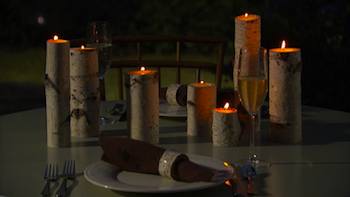By Sean Conway

If you live in or have ever visited northern states such as Minnesota, Alaska, New Hampshire, Vermont or Maine, chances are you have noticed the snow-white trunks of paper birch trees.
These elegant trees are members of the genus Betula and are prized for their beautiful bright white bark with black banding. A stand of these trees is a sight to behold. The celebrated landscape architect Fletcher Steele created perhaps the most iconic planting of these eye-catching trees by lining the Blue Steps with them at the Naumkeag estate in the
While paper birch is truly striking, it is not the only attractive member of the birch family. Another standout tree in this genus is the river birch (Betula nigra). The cultivar 'Heritage' has beautiful salmon-orange bark that peels in horizontal sheets as the tree matures. It is strikingly beautiful and is able to tolerate warmer climates than its white-barked cousin. This tree does well in moist or wet soils, as well as normally drained soil, and will grow from southern New England to Florida, and west to Minnesota and Kansas.
Birch trees are primarily grown for their attractive bark, but there is a variety that is grown for it's attractive foliage. Betula 'Crimson Frost' is a purple-leaved birch with white bark. It is a spectacular tree but is best planted in northern gardens.
Birch wood is very dense, and has many uses. It is used in flooring, plywood, cabinets and for veneer. Recently on "Cultivating Life," we used this versatile and iconic tree to make two projects that will bring a little natural style to your table. Our woodworking expert, Tom Tamborello, showed me how to make candleholders and napkin rings out of paper birch branches.
Whether it's deep in the forest or part of a well-tended garden, the delicate beauty of white birch always seems to stand out. These two easy projects will bring the natural elegance of birch to your table.
The materials you will need include white birch branches at least 2 inches thick, which will be cut to various lengths; some polyacrylic topcoat finish, either clear satin or matte; tea light candles; and some raffia fiber, if desired, to lash some of the candleholders together.
You will also need these tools: a saw, a drill and 1 1/2-inch Forstner bit (a spade or paddle may also be used), a vise, sandpaper and a paintbrush.
We'll begin with directions for the candleholders. Cut birch branches to desired lengths. They can be as short as 2 or 3 inches or as long as 7 or 8 inches. Keep in mind that at longer lengths stability will be a concern. Using the drill and Forstner bit, you will be removing a plug of the branches core slightly larger in size than a tea light, which will be placed in the hole.
Secure a length of branch vertically in a vise. Set the drill into the end of the branch, making sure it is centered, and begin drilling. Drill at least 3/4-inch deep. Remove the branch from the vise and set a votive candle in hole. If you like, use raffia to bind three or more candleholders together (this helps make longer holders more stable when standing on a table). Note: Never leave a lit candle unattended.
Making napkin rings is a similar process. Secure a branch in the vise, as above, and drill at least 1 1/2 inches into the branch. Remove the branch from vise and saw off the hollowed-out section of branch to make ring. Set branch back in vise and repeat to make more rings
Because napkin rings are going to be handled more than the candleholders, they require a bit more finishing. Sand the edges and interior of the rings lightly. Apply two coats of a clear acrylic sealer and let dry.
© Cultivating Life by Sean Conway
AUTOS | HOBBIES | EDUCATION | FAMILY | FASHION | FOOD & RECIPES | HOME DECOR | RELATIONSHIPS | PARENTING | PETS | TRAVEL | WOMEN
Home Decor & Interior Design Birch Beautiful on the Table As Well As in Nature